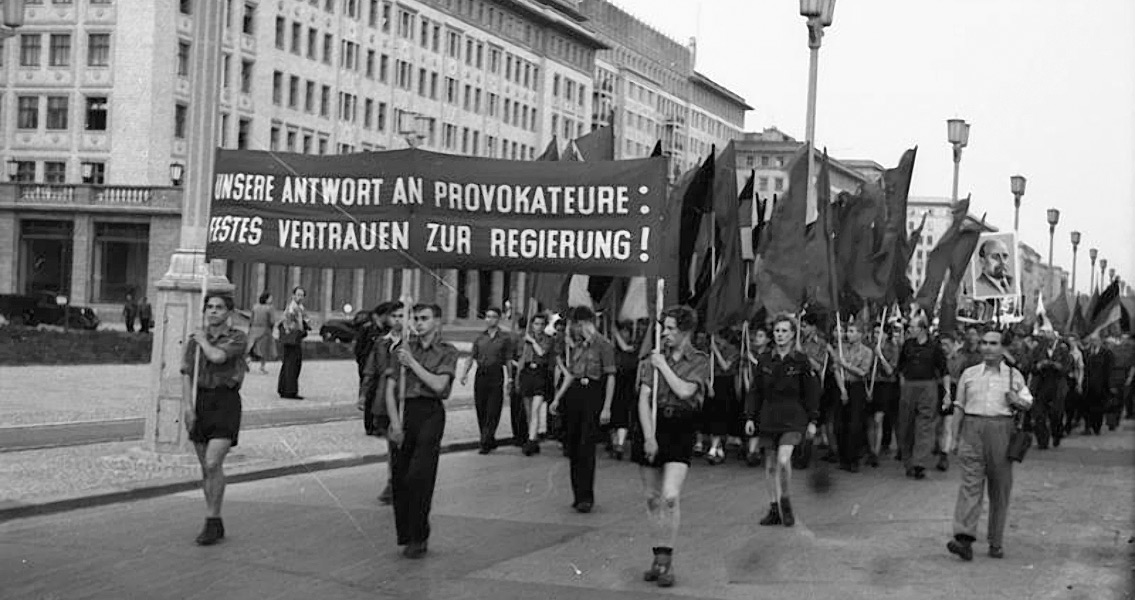<![CDATA[The Soviet Union sent an armoured division to East Berlin in response to a rebellion by German workers and anti-government protesters on 17th June, 1953. Protests had started on 16th June, when construction workers in East Berlin rose against government demands to improve productivity. Angered at the increased work schedules, the workers took to the street in defiance of the East German Soviet government. The following day, the number of disgruntled East Germans protesting in the street had risen to between 30,000 and 50,000. From there the protest escalated quickly, with nearly a million East Germans joining the uprising, leading to riots in other cities and towns. At its root, the riot was the result of the split between East and West Germany. Since the end of the Second World War Germany had been divided into territories to be administered by the Allies (the USA, Britain, France and the Soviet Union). As a Cold War mindset increasingly came to settle over Europe, the polarised interests between the Soviet Union and the other Allies divided Germany. The events surrounding the Berlin airlift in 1948 showed that cooperation between the Allies was over, and Germany was to become the border between East and West, with transport between the two halves increasingly difficult. In May 1952, the Western powers signed the General Treaty in Bonn and the European Defence Community treaties. These were very explicit responses to Stalin's earlier offer to agree to a reunified Germany on the condition that it remained 'unarmed'. West Germany had been very clearly absorbed into the sphere of the Western powers, and moves were made to start developing armed forces in the country. The Soviet Union responded by turning East Germany into a Soviet Satellite state, confirming that what had been Germany was now two very distinct, separate countries. In East Germany, 1952 and 1953 witnessed the quick transition to Communism. Agriculture was forcefully collectivised, an aggressive campaign was launched against private trade and industry, and a drive was started to expand heavy industry in the country. Drastic social changes also took place, re-militarisation forced young men into the Soviet army, religion was suppressed, and any opposition to the Soviet system was met with heavy persecution. A wave of panicked migration took place from East to West Germany as Berliners tried to escape the Soviet Union. By the winter of 1952, a severe food shortage had struck East Germany, a consequence of the rushed implementation of collectivisation. The death of Stalin, in March 1953, seemed to encourage open defiance in East Germany, culminating in the uprising of June 1953. The leaders of the uprising called for a general strike, free elections, and the resignation of the East German government. The Soviet Union's firm response however, quickly established that the death of Stalin would not lead to a loosening of control. Martial Law was quickly declared, Soviet tanks and soldiers attacked the protesters, and by the evening of 17th June the uprising was over. US President Eisenhower ordered a food relief operation for East Germans, the humanitarian campaign seeing food parcels distributed from West Berlin into East Germany. This campaign was perceived as a thinly veiled attempt to undermine the Soviet regime, and by October it had been halted after Soviet authorities started preventing East Germans from receiving the packages. For those on the Soviet side of the Iron Curtain the uprising in East Germany, like those in Prague and Budapest in later years, proved that even after the death of Stalin, political and social repression was the reality in the Soviet Socialist Republics. Image courtesy of Wikimedia Commons user: German Federal Archives]]>
Soviet Soldiers Respond to Uprising in East Germany
